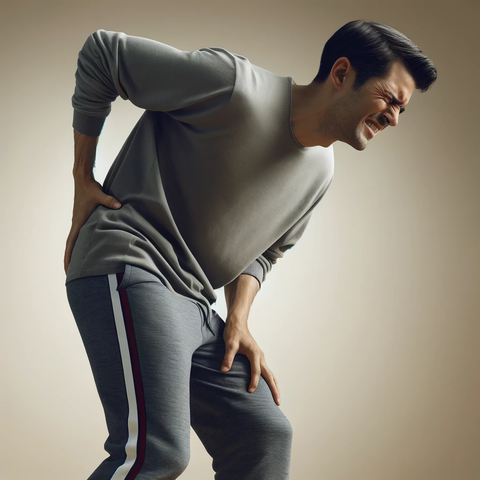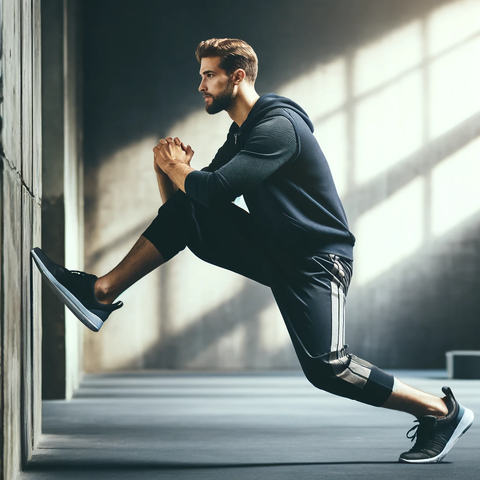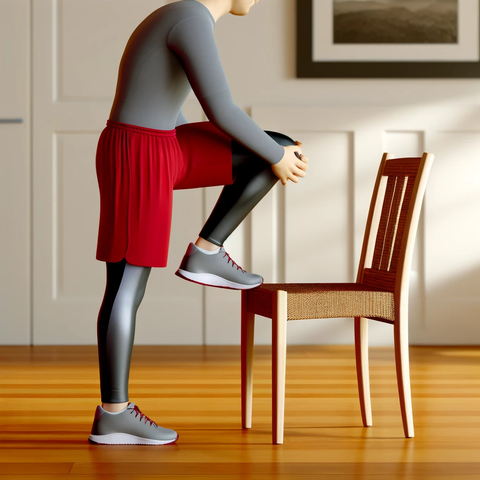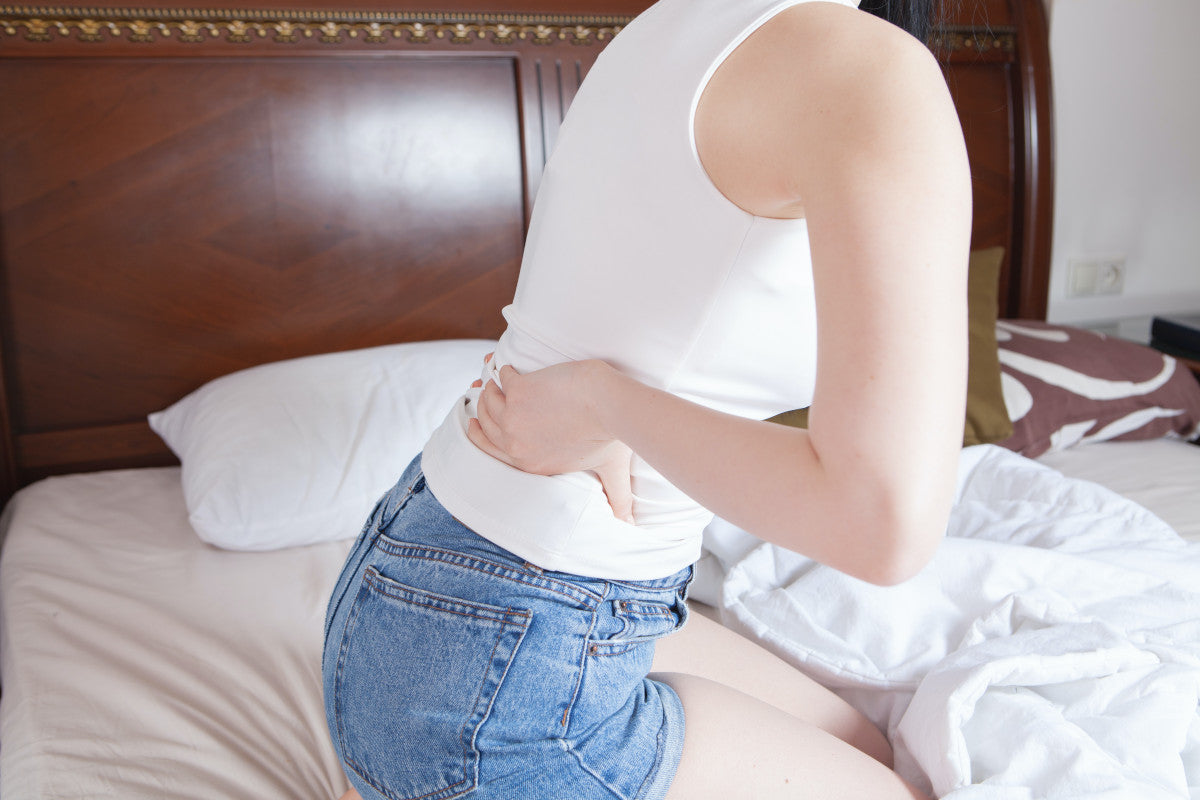Contents (Jump to a section)
Can Tight Hamstrings Cause Back Pain? Demystifying Tight Hamstrings and Back Pain
 Back pain can make life miserable. It can be caused by a number of different factors, and sometimes it can be tricky to pinpoint exactly what the cause is. In this article, we’re going to talk about one of the lesser-known causes of back pain: tight hamstrings.
Back pain can make life miserable. It can be caused by a number of different factors, and sometimes it can be tricky to pinpoint exactly what the cause is. In this article, we’re going to talk about one of the lesser-known causes of back pain: tight hamstrings.
So, can tight hamstrings cause back pain? We’ll answer that question, and take an in-depth look at the link between tight hamstrings and back pain. Plus, we’ve got some great tips for dealing with tight hamstrings and back pain.
Whether you're an athlete, office worker, or anyone experiencing back pain, this article will shed light on the often-overlooked role of tight hamstrings in back pain and help you to better understand and manage this condition.
Can Tight Hamstrings Cause Back Pain?
The relationship between tight hamstrings and back pain has been a topic of debate among healthcare professionals for years. But can tight hamstrings cause back pain, really? Thanks to more research in recent years, several studies now suggest that tight hamstrings can indeed contribute to back pain. In particular, there is a relationship between lower back pain and tight hamstrings.
Why do Tight Hamstrings Cause Lower Back Pain?
So, why do tight hamstrings cause lower back pain? One reason is that tight hamstrings cause other muscles in the body to compensate, including the muscles in the lower back. These compensatory movements can place excessive strain on the muscles and ligaments of the lower back, leading to pain and discomfort over time.
Another way that tight hamstrings and low back pain are linked is through an “anterior pelvic tilt.” When your hamstrings are tight, they cause an increased anterior pelvic tilt, which alters the alignment of the lumbar spine in your lower back. This altered alignment puts increased stress on the lumbar discs, joints, and muscles, causing pain and discomfort in the lower back.
Causes of Tight Hamstrings and Back Pain
We’ve established that lower back pain and tight hamstrings are linked, but how is back pain caused by tight hamstrings diagnosed? Let’s take a look at how a medical professional will determine whether your back pain is being caused by tight hamstrings.
How is the Issue of Lower Back Pain and Tight Hamstrings Typically Diagnosed?
Diagnosing the issue of tight hamstrings and low back pain is usually done by a physician, physical therapist, or chiropractor. Usually, they will first ask you questions about your back pain to find out when it started, how frequent and severe it is, and if it’s triggered by any specific movements or activities.
Then, they will perform a physical examination on your back to look at your posture, range of motion, muscle strength, and flexibility. Similar tests will be performed on your hamstrings, to evaluate tightness and establish whether your tight hamstrings and low back pain are linked.
If necessary, you may receive a referral for imaging studies such as X-rays, MRI (magnetic resonance imaging), or CT (computed tomography) scans. This can help establish a detailed image of the spine and rule out other potential causes of lower back pain, such as disc herniation, spinal stenosis, or fractures.
The Most Common Causes of Tight Hamstrings and Low Back Pain
There are a lot of different factors that can cause tight hamstrings and back pain. Here are some of the most common ones.
- Poor flexibility. If the hamstrings are not stretched regularly, they can become stiff and less flexible, resulting in tightness.
- Muscular imbalances. When muscles around the hamstring (the quadriceps, hip flexors, and glutes) are weak or tight, it can create an imbalance that puts excessive strain on the hamstrings, causing tightness.
- Insufficient warm-ups. Warmups help prepare your muscles for exercise and help them recover faster afterward. If you don’t warm up properly, you are more likely to experience tight hamstrings.
- Overuse/overtraining. Repetitive or excessive running, jumping, or other high-impact activities is one of the most common causes of hamstring tightness.
- Sitting for too long. If you spend long hours sitting at a desk, you can experience hamstring tightness due to reduced blood circulation, muscle imbalances, and decreased flexibility.
- Dehydration. Dehydration can result in reduced hamstring elasticity and flexibility, which causes muscle tightness and discomfort.
- Poor posture. Poor posture can affect the alignment of the spine and pelvis. When you slouch, the misaligned spine and pelvis cause the hamstrings to overcompensate, resulting in tightness.
- Pelvic misalignment. Pelvic misalignments, such as anterior pelvic tilt or pelvic asymmetry, can affect the biomechanics of the hips and result in increased strain on the hamstrings.
Tight Hamstring Sympthoms

When hamstrings are tight, they can significantly impact your mobility and comfort. This condition can lead to a decreased range of motion, making it difficult to bend forward or engage in movements that rely on the hip joints and lower back.
Such restrictions not only affect your ability to perform certain activities but can also interfere with daily routines, emphasizing the importance of addressing tight hamstrings promptly.
Limited Range of Motion
Tight hamstrings can restrict the flexibility and movement of the hip joints, affecting your ability to bend forward or perform activities that involve the lower back.
Discomfort While Sitting
Prolonged sitting can aggravate tight hamstrings and contribute to discomfort or pain in the lower back. This is particularly common for individuals with desk jobs or sedentary lifestyles.
Postural Issues
Tight hamstrings may contribute to poor posture, leading to an increased curve in the lower back. This altered posture can strain the muscles and contribute to back pain.
Radiating Pain
The tension in tight hamstrings can radiate upward, causing pain that extends from the back of the thighs into the lower back.
Muscle Stiffness
Chronically tight hamstrings often result in overall muscle stiffness, making it challenging to move freely and maintain a comfortable, pain-free posture.
Fatigue
The effort required to compensate for tight hamstrings, especially during activities that engage the lower back, can lead to muscle fatigue and discomfort.
Tips for Addressing Tight Hamstrings and Back Pain
Now that we’ve learned more about the causes of tight hamstrings and low back pain, what can you do to address tight hamstrings and low back pain?
Start by Warming the Hamstrings Up Through Heat Therapy
Applying heat to your hamstrings can help increase blood flow, relax the muscles, and improve flexibility. You can use a heating pad or a warm towel, or take a warm bath or shower before stretching or engaging in physical activity that involves the hamstrings. Remember to use heat therapy safely and avoid excessive heat that can cause burns or skin irritation.
Work to Eliminate Hamstring Tightness Through Deep Tissue Work
Deep tissue massage or techniques like foam rolling or using a massage ball can help release tension and tightness in the hamstrings. By applying pressure to trigger points or knots in the muscles, you can help break up adhesions and knots and improve hamstring flexibility. To use a foam roller, place the roller under your hamstring and slide your hamstring over it. Focus more on areas that are particularly sore or tight.
Follow Up With Castleflexx Stretching
Stretching is one of the best ways to improve your flexibility and prevent muscle tightness. The most effective way to stretch your hamstrings is with high-quality flexibility equipment like the CastleFlexx. This portable, ergonomically-designed stretching device makes stretching more comfortable and safer than ever before. Discover the benefits of assisted stretching and learn how to fix tight hamstrings the right way with CastleFlexx.
Stretching your hamstrings is easy with the CastleFlexx. Just find a flat, comfortable surface (like a yoga mat) and lay down on your back. Place your foot inside the CastleFlexx foot hole, then stretch the canvas down the front of your leg and hold onto the handles. Keeping the canvas tight, lift your leg off the ground, point your toes back towards your face, and feel the gentle stretching in your hamstrings. Keep your leg elevated for 30 seconds, then switch legs.
Strengthen Key Muscle Groups: Core, Spinal Erectors, Hamstrings, & Glutes
Strengthening the muscles around the hamstrings, like your core, spinal erectors, and glutes, can help improve overall stability and support for the lower back. Strong muscles can better absorb and distribute forces, reducing the strain on the hamstrings and lower back. You can use the CastleFlexx to do some stretches for tight glutes and fascial stretch therapy to improve the flexibility and strength of these other muscle groups.
You might also like to incorporate exercises such as deadlifts, bridges, planks, and hamstring curls into your fitness routine to strengthen these muscle groups. Learning how to increase hip mobility can help prevent misalignment of your hips and spine, as can improving your overall flexibility. How long does it take to improve flexibility? Not long with the CastleFlexx!
Practice Proper Posture & Make Other Lifestyle Adjustments
Maintaining proper posture while sitting, standing, and lifting can help reduce stress on the hamstrings and lower back. If you have an office job, try making a conscious effort to get up and walk around for a few minutes after each hour of work. Investing in ergonomic furniture, exercising more regularly, and drinking plenty of water can all improve your flexibility, strength, and posture.
You can also check out the CastleFlexx blog for more great tips on how to keep your body healthy and strong. Learn what to do about a tight hamstring causing knee pain, discover how to release tight calves, master how to stretch shins, and find out how long to heal shin splints. Your body will thank you!
Best Stretches for Back Pain and Tight Hamstring
Simple seated hamstring stretch

- Begin by sitting on the floor with both legs extended in front of you. Inhale as you reach your arms overhead.
- Exhale and hinge at the waist, reaching your arms forward toward your toes.
- The extent of your reach depends on your hamstring flexibility.
- Hold the stretch for 15 to 30 seconds before returning to the initial position.
- Repeat this sequence three times.
Supine hamstring stretch

- Begin by lying flat on the ground with your legs extended.
- Bend your left knee, placing the sole of the foot on the floor.
- Hold the back of the right thigh just below the knee, inhale, and gradually straighten the leg. Exhale as you gently draw the leg toward your chest.
- For those with greater hamstring flexibility, consider walking your hands up the raised leg, holding onto the calf for a more advanced stretch.
- Maintain the stretch for 15-30 seconds before transitioning to the other leg.
Standing Hamstring Stretch

- Stand with your feet hip-width apart.
- Extend one leg in front of you, heel on the ground, toes pointing up.
- Keeping your back straight, hinge at your hips and lean forward toward your toes.
- Reach down as far as you comfortably can, feeling the stretch in the back of your extended leg.
- Hold the stretch for 15-30 seconds and switch legs
Towel Hamstring Stretch

- Sit on the floor with your legs extended in front of you.
- Loop a towel around the ball of one foot, holding the ends with both hands.
- Keep your back straight and gently pull the towel towards you, bringing your chest toward your knee.
- Feel the stretch in the back of your leg.
- Hold for 15-30 seconds and switch legs.
Wall Hamstring Stretch

- Lie on your back with your hips close to a wall.
- Extend one leg up the wall while keeping the other leg bent or straight on the floor.
- Flex your foot and press it against the wall, feeling the stretch in your hamstring.
- Hold for 15-30 seconds and switch legs.
Chair Hamstring Stretch

- Sit on the edge of a chair with your feet flat on the ground.
- Extend one leg straight in front of you with your heel on the floor and toes pointing up.
- Keep your back straight and hinge at your hips, leaning forward toward your toes.
- Feel the stretch in the back of your extended leg.
- Hold for 15-30 seconds and switch legs.
Key Takeaways
So, why do tight hamstrings cause back pain? In this article, we’ve taken a look at the complex relationship between tight hamstrings and low back pain. Not only can tight hamstrings cause back pain, but they can also cause issues with other muscle groups and joints. Lower back pain and tight hamstrings shouldn’t be ignored, or your pain will likely become worse over time.
One of the best ways to resolve tight hamstrings and back pain is with the CastleFlexx apparatus. Stretching your hamstrings with the CastleFlexx is easy, comfortable, safe, and highly effective. You can also use the CastleFlexx to relieve tension across your entire body. Sounds great, right?
Start stretching and feel your pain and tension dissolve. Get your CastleFlexx today!
